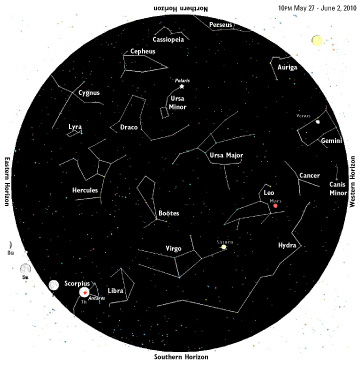Chesapeake Bay's Independent Newspaper ~ Since 1993
1629 Forest Drive, Annapolis, MD 21403 ~ 410-626-9888
Volume xviii, Issue 21 ~ May 27 to June 2, 2010
Home \\ Correspondence \\ from the Editor \\ Submit a Letter \\ Classifieds \\ Contact Us
Best of the Bay \\ Dining Guide \\ Home & Garden Guide \\ Archives \\ Distribution \\ Advertising![]()


Sky Watch

by J. Alex Knoll
Just the Same Old Moon
All those phases are just figments of our own perception
May’s full moon rises at 8:22 Thursday in the southeast just as the sun sets in the northwest. It travels a low, shallow arc through southern skies, finally setting in the southwest just as the sun crests the northeast horizon at 5:44. With spring fully abloom, this is known as the Flower Moon, the Corn Planting Moon and the Milk Moon.
Over the ages we have given the moon its many folksy names to describe the seasons here on Earth. Of course, it’s always the same old moon.
The same holds true for the moon’s phases and the time of day that it rises or sets, a visual effect based on Earth’s position in relation to the moon and sun.
Eclipses aside, the sun is always fully illuminating one-half of the moon’s surface or the other, just as it does here on Earth. But for us to face the fully illuminated half of the moon, Earth must be positioned smack dab in between it and the sun, which happens once every 271⁄2 days. At that time, sunlight washes full over Earth, illuminating the side of the moon directly facing us.
As the moon moves past full, we here on earth no longer face its illuminated face full-on, and it appears to melt away. At last-quarter a week later, Earth is at a right angle in relation to the aligned sun and moon, so we see only half its illuminated half. Another seven days later, the moon rests directly between the earth and sun. Not only is this new moon obscured by the sun’s glare, but its illuminated half faces directly away from Earth.
The full moon is so bright that many of its surface features disappear, and it bleaches out much of the night sky, leaving only the brightest stars visible. One of those stars, Antares, the red heart of Scorpio, shines just one degree below the full moon. So close to the moon, even this star’s distinct red hue fades to white, regaining its fire when viewed through binoculars or a small telescope.
Illustration: © Copyright 1925 M.C. Escher/Cordon Art-Baarn-Holland; Graphics: © Copyright 2010 Pacific Publishers. Reprinted by permission from the Tidelog graphic almanac. Bound copies of the annual Tidelog for Chesapeake Bay are $14.95 ppd. from Pacific Publishers, Box 480, Bolinas, CA 94924. Phone 415-868-2909. Weather affects tides. This information is believed to be reliable but no guarantee of accuracy is made by Bay Weekly or Pacific Publishers. The actual layout of Tidelog differs from that used in Bay Weekly. Tidelog graphics are repositioned to reflect Bay Weekly’s distribution cycle.Tides are based on National Oceanic and Atmospheric Administration and are positioned to coincide with high and low tides of Tidelog.
© COPYRIGHT 2010 by New Bay Enterprises, Inc. All rights reserved.
